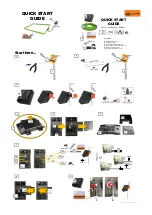
6 Test Procedure
6.1 Line/Load Regulation and Efficiency Measurement Procedure
1. Set up the EVM as described in
2. Ensure that the electronic load is set to draw 0 A
DC
.
3. Increase V
IN
from 0 V to 12 V using the DMM to measure input voltage.
4. Use the other DMM to measure output voltage V
OUT
.
5. Vary the load from 0 A
DC
to maximum rated output A
DC
(TPS544B20 = 20 A, TPS544C20 = 30 A). V
OUT
must remain in regulation as defined in
.
6. Vary V
IN
from 8 V to 14 V. V
OUT
must remain in regulation as defined in
7. Decrease the load to 0 A.
8. Decrease V
IN
to 0 V.
6.2 Efficiency
To measure the efficiency of the power train on the EVM, it is important to measure the voltages at the correct
location. This is necessary because otherwise the measurements will include losses in efficiency that are not
related to the power train itself. Losses incurred by the voltage drop in the copper traces and in the input and
output connectors are not related to the efficiency of the power train, and they must not be included in efficiency
measurements.
Table 6-1. List of Test Points for Efficiency Measurements
TEST POINT
NODE NAME
DESCRIPTION
TP8
VIN
Measurement point for VIN +VE
TP9
PGND
Measurement point for VIN –VE
TP7
VOUT
Measurement point for VOUT +VE
TP11
PGND
Measurement point for VOUT –VE
Input current can be measured at any point in the input wires, and output current can be measured anywhere
in the output wires of the output being measured. Using these measurement points result in efficiency
measurements that do not include losses due to the connectors and PCB traces.
6.3 Equipment Shutdown
1. Reduce the load current on both outputs to 0 A.
2. Reduce input voltage to 0 V.
3. Shut down the external fan if in use.
4. Shut down equipment.
Test Procedure
SLUUAY7B – MAY 2014 – REVISED AUGUST 2021
TPS544x20 Step-Down Converter Evaluation Module User's Guide
11
Copyright © 2021 Texas Instruments Incorporated












































